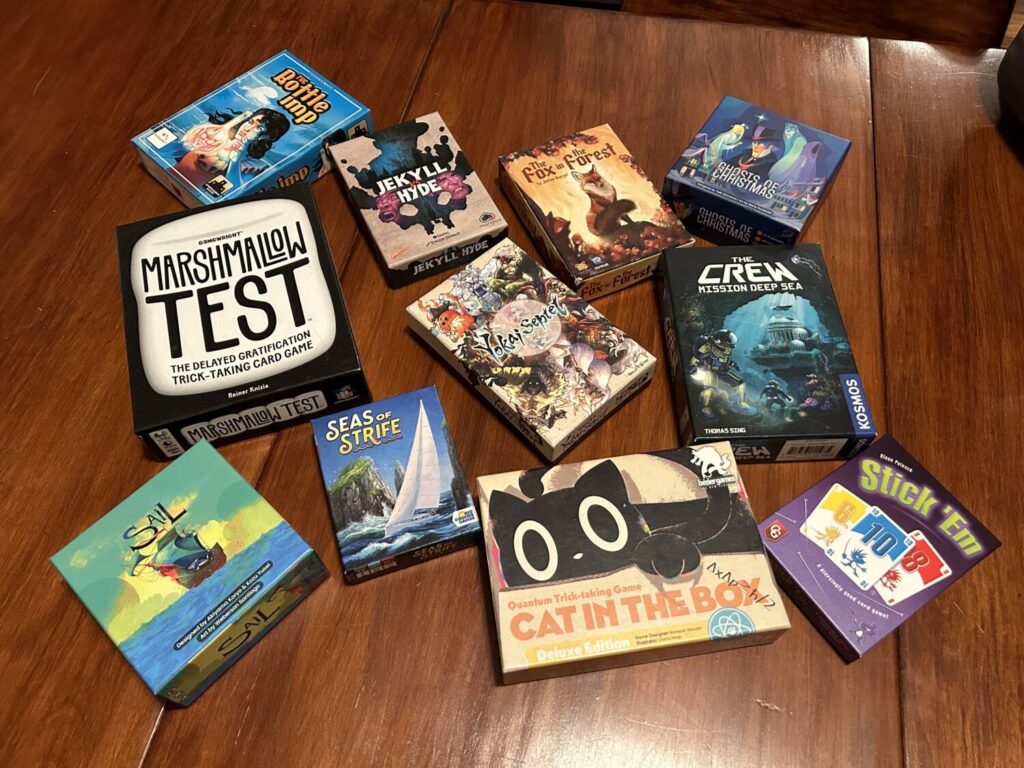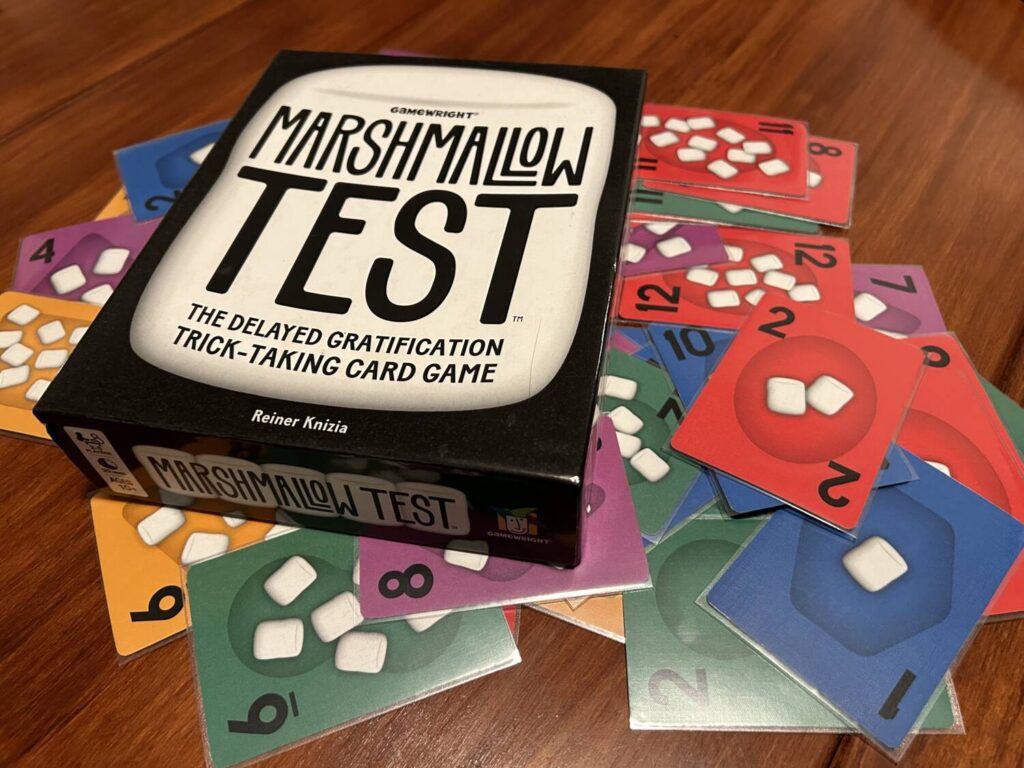Trick-taking is the flavor of the moment in board gaming, there’s no question about it. In part, I am sure, because of the ease of publishing a deck of cards, trick-taking has exploded in the last year and a half, with what seems to be a never-ending torrent of titles coming out every day. For some, that’s a problem. Me, I can’t get enough.
Before we dive into what makes trick-taking games so wonderful, I should make sure everybody knows what we’re talking about here. I’m going to lift from my own work, borrowing the What We Talk About When We Talk About Trick-Taking section from my review of Cat in the Box.

What We, etc.
You’ve probably played a trick-taking game at some point. Spades. Hearts. Whist. Contract Bridge. Oh Hell. Tarot during that semester abroad in Paris. If you haven’t, the fundamental idea is pretty simple. I’ll walk you through a hand, focusing on some key vocabulary that will make it easier to explain games on this list.
Josh leads the trick, which means he plays the first card. Let’s say Josh plays the 5 of diamonds, which he chucks into the middle of the table with resignation.
This trick-taking game is must-follow, which means everyone has to play a card in the same suit as the lead card if possible. Namita has the 3 and Queen of Diamonds. Since the goal of our imaginary trick-taking game is to win as many tricks as possible, she opts to play the Queen.
Nathan sighs. He’s out of Diamonds, so he plays the 2 of Clubs. Since it is off-suit, not in the lead suit, it won’t do anything. This is a lost cause.
Bryan isn’t having any more luck, and puts in the 7 of Diamonds.
Namita takes the trick, since the Queen of Diamonds is the highest card played in the leading suit. She gathers up the played cards and sets them aside. She will lead the next trick, playing whatever card she wants..
There’s one last concept we have to cover: the trump suit. Many trick-taking games use a trump suit, which supersedes the leading suit in deciding who claims the trick. In this example, if Clubs were the trump suit, the trick would instead go to Nathan.
Our key terms here are: Lead; Follow and Must-Follow; Off-Suit; and Trump. If you’ve got a firm handle on all of those, we can move on.
Sticky Tricks
What is it, exactly, that makes this traditional card game format so compelling for those who pray at the altar? Trick-taking games are games of skill, ones that reward memory, gut-feeling, and forethought, and it is entirely possible to get better at them. At the same time, it’s also nearly impossible to play a trick-taking game perfectly. It’s a shuffled deck of cards. The name of the game isn’t perfection; it’s making do with what you have.
As someone who relishes games for the tabletop dramatics, for the reversals of fortune and surprises that cause everyone at the table to raise their voices, there’s nothing like a trick-taker, and it’s hard to imagine there ever will be. Imagine the rush of a pure gambling game with the skill ceiling of Gaia Project. That’s the beauty, my friend.
Separate from my love of the experience of playing a great trick-taker, I also love them intellectually. Because trick-takers share a basic language, they’re a wonderful avenue for exploring game design as an art and science. It’s possible to play two trick-taking games with near-identical rulesets that still, somehow, feel completely different from one another. They’re a source of fascination as well as entertainment.
Naturally, I love sharing my adoration for trick-taking games. Every chance I get, I will happily get one out on the table. But let’s say you don’t own 50+ trick-taking games. Let’s say you don’t own any, or even a deck of cards. What’s the best place to start? Here is a list of some of my favorite trick-taking games.
A Brief Note on the Matter of Qualifications
A bit of bookkeeping before we dive in. Spades, Hearts, Whist, Contract Bridge, Oh Hell, and Tarot are all magnificent games, but I’ll be sticking to contemporary designs for our purposes. Before anyone asks, I am not including climbing games such as Tichu and Scout, as I do not consider climbing games and trick-taking games to be interchangeable. They’re cousins, for sure, but they aren’t the same thing. Finally, for player count, I will include notes about optimal player counts when appropriate.
Standard Trick-Takers
If you’re looking for something fun, unique, and not too far off the beaten path, these trick-taking games offer plenty to chew on while also being approachable enough that your grandma could play. (That’s a rhetorical device. Rest assured, your grandma would whoop you at just about any trick-taking game.)
Seas of Strife

3-6 players (The more the merrier)
Seas of Strife is the golf of trick-taking games. Your goal is to avoid winning tricks. It’s must-follow with two twists:
- As soon as one player plays off-suit, all subsequent players can choose between either of the suits in the trick, regardless of which one was led, which matters because
- The winner of the trick isn’t necessarily the highest card in the led suit. It’s the highest card in the suit with the most cards in the trick.
That means, with the right cards in hand, the players playing later in the trick have a great deal of power. It may also mean, as is more often the case, that the last couple of players spend the trick exhaling an increasingly artful series of swear words, as they realize the corner they’re getting backed into. Dramatic, silly, and brutal, Seas of Strife is trick-taking at its absolute best.
Marshmallow Test

2-5 players (3-4 players)
Taking its name from the famed (and flawed) psychological study, Marshmallow Test is a house favorite. Players are eliminated when they win a set number of tricks. That’s good. You want to be eliminated, because the last player left doesn’t score any points. Having said that, you want to get eliminated as late as possible, because you score one point for each trick all of your opponents have won during the round. Marshmallow Test is a rambunctious and snappy game of chicken.
If that weren’t enough, it also comes with squishy marshmallow counters for tracking your score between rounds.
Check out our review of Marshmallow Test.
What’s in the Box? Pain.

Trick-takers can get nasty when they want to. Seas of Strife qualifies for this category, but it’s so approachable that I left it in the Standard section. Here are two trick-taking games to break out when everyone at the table is ready to hate everyone else just a little bit more than they already do.
Stick ‘Em
3-6 players (3-4 players exclusively)
The nastiest game on the list, Stick ‘Em is all about avoiding cards in a suit you choose for yourself at the beginning of the game. While you score one point for every card you win through tricks during the round, you also lose points equal to the combined value of all the cards you’ve won in your Pain Suit. The mechanical hook in Stick ‘Em is simple enough: you can always play off-suit, but the winner of the trick is the highest off-suit card. The implications of that for decision-making won’t make sense to you until you start playing the game, but it’s a great idea.
It takes time to understand the best methods for choosing your Pain Suit, and Stick ‘Em can often be won by simply avoiding any tricks, but good luck with that. Your “friends” will always figure out how to stick you where it hurts.
The Bottle Imp
3-4 players (3 players)
There’s a lot going on in The Bottle Imp, and I’m still not sure I’m anywhere close to understanding it, but it’s a magnificent game. The titular bottle imp is a card nobody wants, and it gets harder and harder to get rid of it as the round continues. Like Marshmallow Test, the emotional dynamic of The Bottle Imp is best described as a game of chicken. Players are constantly trying to shake that bottle as late in the round as possible. Otherwise, it might come back.
While Bottle Imp is hard to find at the moment, it is getting a new, much prettier edition later this year.
Two Player

Sometimes you want to play a trick-taking game, but you don’t have a group of people. I’ve been there. If you can scrape up even one person, though, you can still get a pretty good game going.
The Fox in the Forest
2 players
A two-player staple at this point, The Fox in the Forest excels through a combination of its clever card powers and the scoring system. Every odd card has an ability that interacts with the decision space in some deeply pleasing way. Points are scored based on the number of tricks you win, but be careful; win too many, and you won’t score anything. This is The Fox in the Forest’s brilliant workaround for when one player or the other draws what would normally be too strong a hand. Suddenly, that’s a liability. Punchy, quick, and with a minimal footprint, The Fox in the Forest deserves its place in the gaming firmament.
Jekyll vs Hyde
2 players
Where The Fox in the Forest is pleasantly tense, Jekyll vs. Hyde is simply tense. Over the course of three brisk rounds, Dr. Jekyll and Mr. Hyde pursue contradictory goals. Jekyll wants both players to win as close to the same number of tricks across each hand as possible, while Hyde wants a significant gap. The game makes masterful use of special powers associated with each of the three suits, which keep things fresh for play after play. This is also the only game on this list to make use of ranked suits. The three suits exist on a cline, formed as the game is played. The later a suit is first played during the round, the more powerful it is.
Cooperative

What if you want to sling some cards, but you don’t want to resent anyone? Looking for a certain spirit of camaraderie? We’ve got that covered.
The Crew: Mission Deep Sea
3-5 players (All good)
The Crew: The Quest for Planet Nine was a big hit, one of my all-time favorite games. Mission Deep Sea, the sequel, has managed to improve on the formula in a number of ways, and may be the best game on this list. Players work together to accomplish a series of tasks, which can be something as simple as “I will win the green 6” or as complicated as “I will win an 8 using a 4.” Like many cooperative games, The Crew enforces communication restrictions, with a clever system for letting everyone else know what one of your cards is. Both versions of The Crew leave space for a wondrous meta-game to form, as players figure out the nuances of what they can and can’t communicate. The Quest for Planet Nine is still a wonderful game, and if you’re worried about getting overwhelmed, that might be the better place to start. Mission Deep Sea adjusts better to different player counts, and it is ultimately a much more challenging design for you to really get into.
Sail
2 players
Work with your co-pilot to steer your vessel to safety, all the while trying to fight off the perilous Kraken and avoid other seaborne obstacles. Sail is an interesting design, a challenging and punishing cooperative game that looks pretty enough to lull you into forgetting that the game wants you, and everyone you’ve ever loved, to fail. Success in this game depends on playing your cards just right. While that can be difficult, getting it right is incredibly satisfying. Sail is a great game to play over and over with the same person, developing a comfortable meta.
Teams
I love a team-based trick-taking game, especially the moment of the card swap. In most partner trick-taking games—Sail included—you start the round by passing a card to your partner. This is often a desperate last attempt at telling them something. The terror of anticipation around whether or not they play as you want them to? That’s what it’s all about.
Yokai Septet

3-4 players (4 players exclusively)
The goal is to win all the 7 cards in the deck, but that’s easier said than done. Each suit has a 7, but the distribution of the remaining numbers varies from suit to suit, which effects play in unanticipated ways. More than that, Yokai Septet takes a page from The Fox in the Forest’s book. The round ends either when one team or the other has claimed enough of the 7’s to win, or either team has won too many tricks while gathering too few 7s. Yokai Septet is a game that grows on you with time, and is ideal for a group of four looking for something to cut their teeth on.
Read our review of Yokai Septet.
Weird
Because the foundations are so well-established and so well-understood, trick-taking games can get rull weird when they want to. Here are a few of my Freak Flag favorites.
Ghosts of Christmas

3-4 players
Taiki Shinzawa is one of trick-taking’s great mad scientists, and Ghosts of Christmas is, well, for anyone else, it would be their opus. More on that in a moment. On the surface, Ghosts of Christmas is a standard trick-taking game with bids, when players say how many tricks they think they’ll win before the hand starts. Under the hood, this game plays with time. Tricks can be played in the Past, Present, or Future, but they aren’t resolved until everyone has a card in each slot. The winning suit of the first trick becomes the trump suit of the second, and so on. It’s a delightful cascade of consequences, not all of them foreseen.
Cat in the Box

2-5 players (3-4 players)
A banananuts exercise in pushing trick-taking to the very limits of what it can do, Cat in the Box is a masterwork. The cards in the deck have no suit, only a value, and the suit is declared by the player playing the card. In Cat in the Box, you are not obliged to follow. You can declare any card to be whatever color you want, so long as that number hasn’t been that color yet this round. The catch is, if the first player leads with green and you follow with red, you’re not allowed to play green again for the remainder of that round. This is a trick-taking game in which you can decide, at any moment, to short-suit yourself, a fascinating risk/reward dynamic. Most everyone jams themselves up in some way, and that’s half the fun. As each round draws to a close, everyone is sweating bullets as they try to not be the person who gets tripped up first.
Deal Me In
I imagine I will reach a saturation point with trick-taking games sometime within the next year. Like the culture at large, I’m a cyclical creature. Until then, though, I can’t wait to see what this design space has in hold in the coming year. Every time I think it’s out of ideas, something new pops up.






















Hey! Great review.
I missed a great solo trick taker game though: For Northwood!
For Northwood! is an absolutely lovely design, I agree! Trying to do something as inherently social and reactive as a trick-taking game with only one player is a great design challenge, and For Northwood! managed to pull it off. I didn’t include it on this list because I was imagining this as a consumer guide for someone staring at a shelf full of trick-taking options, and I don’t think For Northwood! would generally come up under those circumstances.